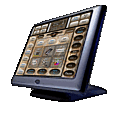 |
|
|
ABOUT
REMOTE CONTROL SYSTEMS...
So in 1950, building on wartime research and peacetime consumerism, Zenith introduced the first TV remote control. Called the “Lazy-Bones”, it could turn the TV on and change channels. It was wired to the TV and a motorized unit physically rotated the tuner knob. It is said that the motivation at Zenith was a management-level distaste for advertising on TV and an effort to undermine the commercial broadcasting model. If enough people could block the commercials, surely they would go out of style.
Undaunted, Zenith moved from light to sound in 1956 with the "Space Command" remote control. It had little rod-shaped bells inside, struck by a small spring-loaded hammer when the button was pushed. At the TV set, a microphone listened for the frequency of the ringing and triggered the desired action – mostly. If there was too much noise, the bell would not be heard, or worse, the noises would trigger undesired actions. The worst cases were pet owners who were chagrined by new channels appearing whenever their dog scratched and his collar tags jingled. And the device added about 30% to the cost of the set! The noise made by
these early mechanical remotes also gave them the nickname that has
endured despite the eventual elimination of any sound at all - "the
clicker."
Hand-held wireless
remote controls were variations on the Space Command theme in the early
60’s, though functions remained few. As color TV became the norm
but good color reception was still touchy, users needed to tweak color
and hue almost endlessly, as well as to diddle with the fine tuning.
The precise control of “IR” remotes, combined with the change to automatic fine tuning and color adjustment made this design the standard for nearly everything built since the early ‘80s. The remote and the TV must have an unobstructed line-of-sight between them because the communication is again optical, and strong daylight can make commands fail, but it works well for most purposes. By 1985 and ever since, more TV’s were sold with remote controls than without.
More than just sowing
the seeds of couch-potatoes, remote controls have changed the TV programming
and advertising industry - but not in the way the early Zenith management
hoped. Since relief from boring, annoying, or just unstimulating visions
is just a click away for nearly everyone, the pressure is enormous to
keep every moment as riveting as possible. Quick-cut scenes, one program
segueing into the next, elimination of opening themes, shorter and more
visually striking commercials, and increased integration of advertising
and program content ("Product Placement") are all fallout
of the remote control-assisted short attention span. |
Copyright 2007 by GP Systems, Inc.









 When
TV really took off, there were few channels
and even fewer adjustments. There was mostly OFF, ON, VOLUME, and CHANNEL.
There was one TV, in the living room, and if Dad wanted to change the
channel, he got up and did it. The first TV remote control was Dad telling
Junior to do it, but not for long. Not everyone had a junior, after
all.
When
TV really took off, there were few channels
and even fewer adjustments. There was mostly OFF, ON, VOLUME, and CHANNEL.
There was one TV, in the living room, and if Dad wanted to change the
channel, he got up and did it. The first TV remote control was Dad telling
Junior to do it, but not for long. Not everyone had a junior, after
all. The Lazy-Bones tether was annoying and a hazard to household traffic,
so in 1955 Zenith replaced it with the first-ever wireless remote, futuristically
called the “Flash-Matic”. It operated by means of four photocells,
one in each corner of the TV screen. A ray-gun styled flashlight activated
the four control functions, which turned the TV and sound on and off
and turned the channel tuner. However, the Flash-Matic had many problems
working on sunny days or in brightly lit rooms.
The Lazy-Bones tether was annoying and a hazard to household traffic,
so in 1955 Zenith replaced it with the first-ever wireless remote, futuristically
called the “Flash-Matic”. It operated by means of four photocells,
one in each corner of the TV screen. A ray-gun styled flashlight activated
the four control functions, which turned the TV and sound on and off
and turned the channel tuner. However, the Flash-Matic had many problems
working on sunny days or in brightly lit rooms.

 The
next refinement of remote controls – again by Zenith - eliminated
physical bells and used near-inaudible high frequency sounds generated
by new transistor circuits. Electronically generated tones could be
specific enough to have fewer errors and more functions. Despite annoying
children and pets who could hear the high-pitched whistle sounds, this
design held sway through the 70’s, until the arrival of infra-red
communications brought an end to acoustic remotes.
The
next refinement of remote controls – again by Zenith - eliminated
physical bells and used near-inaudible high frequency sounds generated
by new transistor circuits. Electronically generated tones could be
specific enough to have fewer errors and more functions. Despite annoying
children and pets who could hear the high-pitched whistle sounds, this
design held sway through the 70’s, until the arrival of infra-red
communications brought an end to acoustic remotes.